This fall, the ASTRO Center and the Department of Aerospace Engineering at Texas A&M University partnered with Made in Space to take advantage of the 3-D printer aboard the 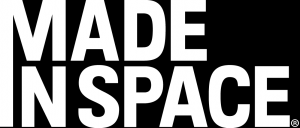 International Space Station (ISS). Made in Space is a San Francisco based startup that focuses on additive manufacturing, which launched a 3-D printer to the ISS in September 2014. The company is due to launch its second 3-D printer to the ISS soon. Gregory Chamitoff, director of the ASTRO Center engaged Made in Space to create an environment where the 3-D printer and its capabilities could be paired with the creativity of college students, and Texas A&M was the perfect place to create such an environment. David Kanipe, Professor of Practice at the Dept. of Aerospace Engineering at A&M co-directed these efforts.
International Space Station (ISS). Made in Space is a San Francisco based startup that focuses on additive manufacturing, which launched a 3-D printer to the ISS in September 2014. The company is due to launch its second 3-D printer to the ISS soon. Gregory Chamitoff, director of the ASTRO Center engaged Made in Space to create an environment where the 3-D printer and its capabilities could be paired with the creativity of college students, and Texas A&M was the perfect place to create such an environment. David Kanipe, Professor of Practice at the Dept. of Aerospace Engineering at A&M co-directed these efforts.
Together with Magdalini Lagoudas, executive director for industry and nonprofit partnerships in Engineering Education & Academic Affairs (EASA), Chamitoff put a proposal together to  have college-level students compete in a highly intensive manner. Over the span of 48 hours students were challenged with creating 3-D printable objects that address the needs of space flight — specifically within the International Space Station.
have college-level students compete in a highly intensive manner. Over the span of 48 hours students were challenged with creating 3-D printable objects that address the needs of space flight — specifically within the International Space Station.
The competition was created as part of the Aggies Invent Design Weekend, a program in place at Texas A&M that facilitates these competitions with physical resources and tools to allow multidisciplinary teams to push their innovation, creativity and communication skills. Rodney Boehm was in charge of organizing the event according to the Aggies Invent format. Jim Morrison, manager of the Engineering Innovation Center (EIC) worked tirelessly to ensure the facility was up to date with the required resources and hardware necessary for the students to succeed.
The competition was held Sept. 4-6. It involved 60 students split into 10 teams. Each team had a particular need to address, and each need was sponsored by a mix of representatives of organizations and industry mentors.
Mentors involved included former NASA astronaut Joseph P. Kerwin, who was pilot for the Skylab 2 mission, Dr. Bob Skelton, who designed control systems for Skylab 2 and who is a member of the National Academy of Engineering, George James and Daniel Jackson from NASA, Dr. Jason Held from Saber Astronautics Australia, Senior manager from Wyle, Kiley Wren, former NASA division Chief David Kanipe and former NASA astronaut Gregory Chamitoff.
The mentors provided initial input to the students to help them form a team with the right skills for each need. After the teams were formed, they worked to extract as much information as possible from the mentors to get a clear picture of the need and how to address it.
Most teams started by building initial concepts and progressed from those initial designs to working prototypes and final designs.
With time running down, teams concentrated on getting their final project presentation ready and rehearsed.
The teams were required to present to a panel of judges including: former NASA astronaut Ken Bowersox; the President of Made In Space, Andrew Rush; and Senior Associate Dean of Research Dr. Dimitris Lagoudas.
The judges scored the projects and provided valuable feedback to the students, while carrying out the tough job of selecting the top three teams. The top three teams were awarded cash prices of $500, $750 and $1,000.
Stellarponics was the top team in the event, with Direc2Mars placing second and Space Sip finishing third.
Some of the projects are showcased below:
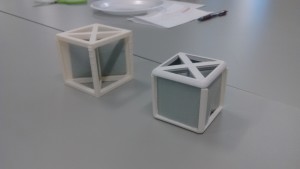
Several configurations of the sweeper cube.
Clean sweep. Foreign object debris can be a danger to astronauts on the ISS. Current ISS environmental controls take many hours cycling the air through the station, therefore there is a need for a more immediate debris removal. Clean Sweep came up with a cube-like object that maximizes surface area so that a sticky surface can clean the environment inside the ISS. This device can circulate throughout the ISS and collect stray debris, or be carried by an astronaut and swept through the air when needed. This cube-like sweeper features a large safety factor and maximum surface area for its size, in addition to an easy removal and replacement of the spent sticky surfaces (duct tape) to ensure easy maintenance. It can be 3-D printed on the ISS and therefore has the advantage to be manufactured on site, making it easy to maintain and use.
Cube Station: This team was tasked with creating a CubeSat structure that can be printed and assembled on the ISS to support a payload similar to the Planet Labs Dove Satellites. Their design had the parts printed with hinges and snap posts to allow for easy assembly. They optimized the structure through several iterations of their design. Also, knowing that ABS plastic could not dissipate charge like an aluminum structure, they isolated all inside components with a Faraday cage to ensure proper isolation of any electronic devices within the housing. Cube Station’s appeal comes from the fact that the structure printed in space is much lighter than one manufactured on the ground since it does not need to sustain launch loads, allowing less weight in materials to be sent to the ISS. The lower weight reduces costs and makes it easier for small corporations to deploy satellites from the ISS.
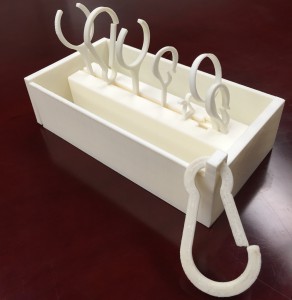
AstroLoc device with a variety of restraining tools attached to its telescoping boom.
AstroLoc: The astronauts aboard the ISS have many tools and objects they use every day for their activities. In the microgravity environment these objects float around, making it necessary to Velcro them to a wall or stowing them when not in use. Therefore there is a need for reliable, versatile organization equipment. The AstroLoc is a box with various multipurpose restraining tools to attach many objects to it. This box features a telescoping mechanism to increase the storing area of the AstroLoc. The restraining tools come in a variety of shapes and sizes, such as clips, hangers, pinchers and hooks. AstroLoc can be printed in one single print which makes it very it very efficient to build. This device adds the convenience of being able to move all tools at once. Therefore astronauts can save time and energy by not having to keep track of individual items. Such a device is an asset because in space every second counts.
Mars Mission: In future mars missions, 3-D printers could be a critical asset to print tools on demand, and create solutions to problems that arise without the expense of having to send everything that may be useful. This team addressed the ways this could be done by tackling a challenge inspired by the events in the book and movie The Martian. They designed a superior solution to those the protagonist used, by including the use of a 3-D printer. The team’s design included a set of gears, rack and pinions, and Morse coding to record detailed messages from Earth to Mars using only the rotation of a camera boom.
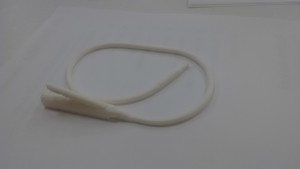
3D printed catheters made of silicone could be very useful in medical scenarios.
Catheter: Deciding what to pack in a medical kit for spaceflight can be difficult, There is a trade off between weight and volume, and having equipment to deal with as many scenarios as possible. Being able to print devices such as Foley catheters would be extremely valuable. These devices are not frequently needed, but are critical to have. The team tackled this need by creating a design for a 3-D printed version, including an inflatable component to hold the catheter in place. Their design would be printed with silicone to provide the required flexibility and a hydrophilic coating to alleviate the need for lubricants. Sterilization was a key aspect, and the team considered UV sterilization and future methods to print directly into a sterile bag.
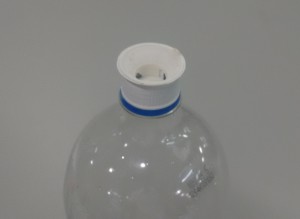
The Space Sip cap fits into any regular bottle and also the Saber Astronautics patented straw (not shown).
Space Sip: Currently, drinkable liquids on the ISS are stored in single use pouches that need to be punctured, and the liquid drank all at once through a straw. These pouches cost $1.4 million a year to NASA, and are disposed of once used. The ground-based experience of sipping by tilting the liquid’s container is lost in microgravity. Saber Astronautics has come up with a patented capillary action straw that draws liquids from traditional looking bottles and allows the astronaut to drink as we would on Earth. Saber Astronautics needed a cap that prevents their device from spilling, while supporting the function of the device. The Space Sip team came up with a cap that provides the Earth-like drinking experience in space. This cap is similar to a bottle cap used in everyday life, but with a cavity to support drinking in microgravity, and is faster to switch on and off so that astronauts can control the flow through the bottle with more ease. This technology could provide lots of savings through recycling the caps, and enables astronauts in the ISS to drink just like they do on Earth.
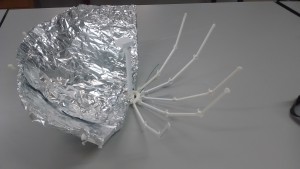
Mylar cover, receiver and rib structure can be seen in this prototype by Direc2Mars.
Direc2Mars: This team was able to solve a Mars mission communications failure scenario, in which lack of communication between a crew and the ground can prove to have serious consequences. Direc2Mars designed a 3-D printable communication antenna for such emergency situations. The reflective surface of the parabolic concentrator is made out of Mylar, supported by shaped series of ribs that are 3-D printed. These special wrench-like ribs allow the concentrator to change shape and be easily tweaked to best assimilate the correct concentrator shape needed. In the center, a threaded fitting allows the receiver to move the focal point up and down to further capture the optimal signal strength. The structure of this efficient and simplistic design features all 3-D printable components, which means maintenance and assembly is easy, just what is needed in an emergency scenario.

A tensegrity prism like the one shown could one day be used as fundamental building block in space.
Tensegrity Prism: Future space structures are going to be large and complex. The concept of tensegrity, developed by Dr. Bob Skelton, envisions a structure that can be used in a fractal-like way to create as large or small space structures as possible. Therefore, Tensegrity Prism created a 3-D printable structure that acts as a fundamental building block. This prism is made up of three rods and nine pre-tensioned strings. They are arranged in such a way that the load bearing mass is reduced by 90 percent, and is completely foldable to a relaxed state that can save a lot of space. Tension is given to the structure by using shape memory plastic. This polymer shrinks as it cools, giving the tension that is key to the load bearing capabilities. As the prism is being printed, the heated bed acts as a buffer to keep the plastic strings in a relaxed state. As the final product cools down it tenses, which create the load-bearing prism. All prisms are joinable at the ends to create multiple building blocks. This technology can be used for prototype robots, fully self-sustaining habitats, shelter in emergency environments and every prism can be controlled independently through heat, therefore having a controllable aspect intrinsic to the structure itself.
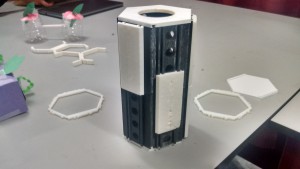
Hydrocaps container with replaceable parts can be seen in this image.
Stellarponics: Inside the ISS there is a lot of light and water, but no soil. Soil is expensive to launch from the ground and its nutrients are depleted after a few seasons of harvesting. As such, hydroponics is more suited to growing food in space. Stellarponics addressed the issue by creating Hydrocaps. This container uses preexisting light and water to grow vegetables without soil. Hydroponic plants grow up to 50 percent faster than soil plants, which could provide a fresh and continuous supply of food to astronauts living in the ISS. This container is able to produce the maximum amount of food per unit volume through the hexagonal shape, and several containers can be joined to create expandable structures with large flexibility in how they are arranged. The hydroponic plant is submerged in water within the container, which holds the water mostly through surface tension. The plant is then able to grow in whichever way is most efficient through the various holes in the container. Sliding caps are there if the plant is to be grown out of specific holes. This container allows for easy-to-grow root-based plants and it is reusable, and harvesting is easy due to the sliding caps.

Stereolithography printed chip (grey) can be seen in comparison to the detector structure.
Heilsa: Lab-on-a-chip diagnostics is an up and coming field on Earth, but currently there are no analogous technologies for use in space. Heilsa (Icelandic for health) has created a lab on a chip that exploits capillary action to take fluid through a variety of detectors. This device, through the use of capillary action, works in space and therefore enables astronauts to have onboard diagnostics for any potential health complication they might have. All the astronauts must do is place their finger on a small puncturing hole, and blood will flow through the chip. Many kinds of detectors can be placed on top of the chip to enable diagnostics of diseases, dietary imbalances and other health issues. The platform can be easily redesigned so that it can be changed to doctors’ needs and specifications allowing for future needs to be met without knowing today what those will be. This device has no external actuation so it is very simple to print and maintain, and, apart from the printer required to print it, no special equipment has to be launched.
Stellarponics’ design will soon be printed and tested aboard the ISS, with the use of a Made in Space printer. To find out more information about this event click here.




